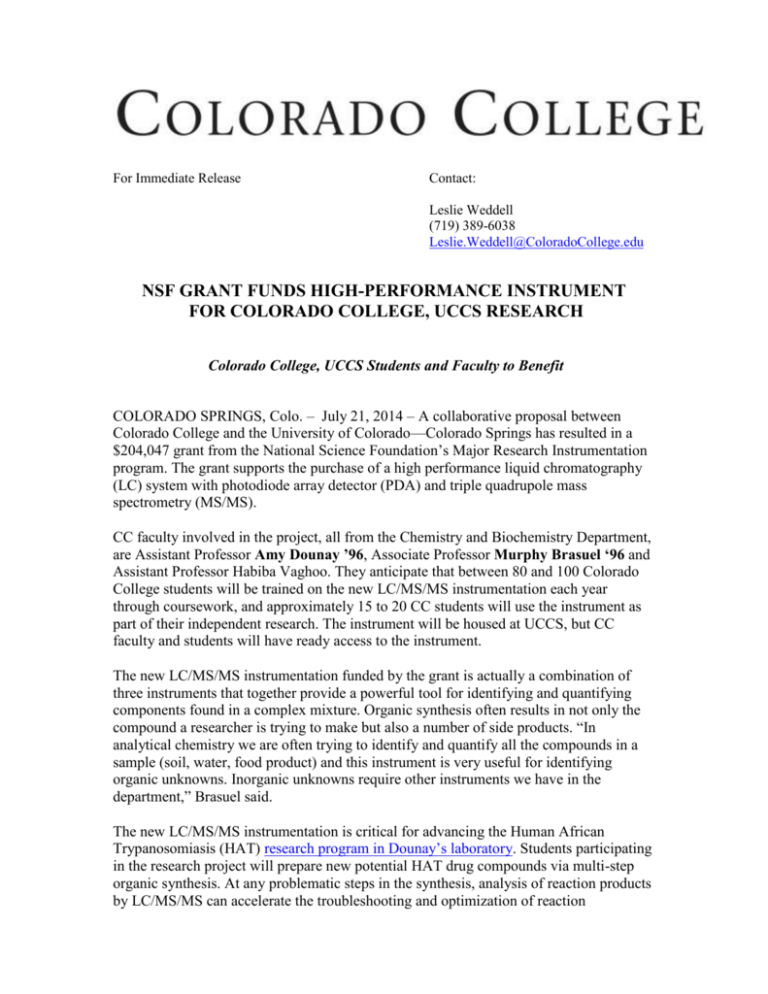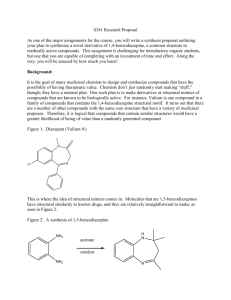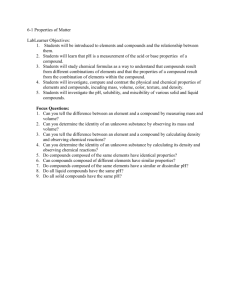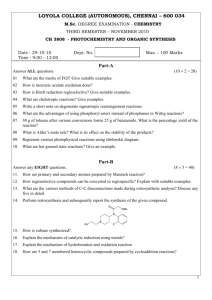NSF Grant Funds High-Performance Research
advertisement

For Immediate Release Contact: Leslie Weddell (719) 389-6038 Leslie.Weddell@ColoradoCollege.edu NSF GRANT FUNDS HIGH-PERFORMANCE INSTRUMENT FOR COLORADO COLLEGE, UCCS RESEARCH Colorado College, UCCS Students and Faculty to Benefit COLORADO SPRINGS, Colo. – July 21, 2014 – A collaborative proposal between Colorado College and the University of Colorado—Colorado Springs has resulted in a $204,047 grant from the National Science Foundation’s Major Research Instrumentation program. The grant supports the purchase of a high performance liquid chromatography (LC) system with photodiode array detector (PDA) and triple quadrupole mass spectrometry (MS/MS). CC faculty involved in the project, all from the Chemistry and Biochemistry Department, are Assistant Professor Amy Dounay ’96, Associate Professor Murphy Brasuel ‘96 and Assistant Professor Habiba Vaghoo. They anticipate that between 80 and 100 Colorado College students will be trained on the new LC/MS/MS instrumentation each year through coursework, and approximately 15 to 20 CC students will use the instrument as part of their independent research. The instrument will be housed at UCCS, but CC faculty and students will have ready access to the instrument. The new LC/MS/MS instrumentation funded by the grant is actually a combination of three instruments that together provide a powerful tool for identifying and quantifying components found in a complex mixture. Organic synthesis often results in not only the compound a researcher is trying to make but also a number of side products. “In analytical chemistry we are often trying to identify and quantify all the compounds in a sample (soil, water, food product) and this instrument is very useful for identifying organic unknowns. Inorganic unknowns require other instruments we have in the department,” Brasuel said. The new LC/MS/MS instrumentation is critical for advancing the Human African Trypanosomiasis (HAT) research program in Dounay’s laboratory. Students participating in the research project will prepare new potential HAT drug compounds via multi-step organic synthesis. At any problematic steps in the synthesis, analysis of reaction products by LC/MS/MS can accelerate the troubleshooting and optimization of reaction conditions, Dounay said. “Additionally, characterization of all key intermediates and final analogs by LC/MS/MS is standard in the field of medicinal chemistry, and these data are required for publication of our results,” she said. In the case of the specific compounds under investigation, LC/MS/MS analysis, in conjunction with nuclear magnetic resonance (NMR) spectroscopy, is the optimal method for definitive characterization of the targeted compounds. Brasuel will be conducting research on “Identification and Quantification of Engineered Nanomaterials in Environmental Samples,” with the long-term goal of developing analytical methods for the identification and quantification of engineered nanomaterials in aqueous samples. As the application of nanomaterials across numerous technology sectors continues to grow, further assessment of these materials’ unique toxicity profiles and environmental impacts are required, he said. In order to support these assessments, new analytical methods are needed. “While simple LC/MS would be suitable for quantification of carbon nanotube loads in ‘clean’ samples, environmental samples will contain carbon compounds from a wide variety of sources, both natural and anthropogenic,” Brasuel said. “The increased analytical capabilities of the LC/MS/MS is required for the analysis of such environmental samples.” Vaghoo’s research focuses on the design and synthesis of fluorinated analogs of antimalarials belonging to the 4-aminoquinoline class using microwave assisted synthesis. Chloroquine is perhaps the most commonly known 4-aminoquinoline based antimalarial, but the emergence of a Chloroquine-resistant parasite has made its use obsolete in most parts of the world. Amodiaquine and Tebuquine (also 4aminoquinolines) are active against Chloroquine-resistant strains of malaria, however, their use has been limited due to harmful side effects. Vaghoo and her researchers are working on a multi-step synthesis of CF2H analogs of Amodiaquine. “The objective is to utilize microwave technology for the synthesis in order to develop new reaction methodologies as well as synthesize fluorinated antimalarial analogs,” she said. LC/MS/MS instrumentation is an integral method for the analysis of complex mixtures in synthetic organic chemistry, Vaghoo said. “Access to this method of analysis will be most useful for optimization of reactions, as it enables analysis of complex reaction mixtures of high- polarity and molecular weights.” In addition to the ongoing research projects, the instrumentation will be incorporated into both introductory and advanced courses at CC. These courses will include Reactions of Organic Molecules, Synthesis of Organic Compounds, Introduction to Analytical Chemistry, and Introduction to Instrumental Methods. How the instrument works: The HPLC separates components of a complex mixture from each other so they can be analyzed individually. Without this separation the data from PDA and the MS would have overlapping data from all of these individual compounds. This would make it nearly impossible to identify and quantify the compounds present. Once the compounds are separated the PDA analyzes how the individual compounds absorb light. How long a compound takes to move through the HPLC (elution time) and the how it absorbs light can be used to give a rough identification of the compound (for simple mixtures elution time and the PDA data is all that is needed for identification and quantification). The MS part of this instrument provides an even more powerful method of identification. Energy is added to the individual compounds as they pass from the PDA into the MS. This energy results in a charge on the compound and it falls apart in a particular pattern as it tries to stabilize this charge. The pattern of fragmentation can help you piece back together what the original molecule was. Having a triple quadrupole allows you to fragment a compound more than once and this increases both your ability to identify the compound as well as increases your ability to measure very small amounts of compound. Further contacts: Murphy Brasuel (719) 227-8256 mbrasuel@coloradocollege.edu Amy Dounay (719) 389-6438 amy.dounay@coloradocollege.edu Habiba Vaghoo (719) 389-6746 habiba.vaghoo@coloradocollege.edu About Colorado College Colorado College is a nationally prominent, four-year liberal arts college that was founded in Colorado Springs in 1874. The college operates on the innovative Block Plan, in which its approximately 2,000 undergraduate students study one course at a time in intensive 3½-week segments. The college also offers a master of arts in teaching degree. For more information, visit www.ColoradoCollege.edu






